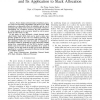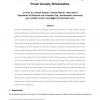IPPS
2010
IEEE
14 years 12 days ago
2010
IEEE
Abstract--Power density and heat density of multicore processor system are increasing exponentially with Moore's Law. High temperature on chip greatly affects its reliability,...
MICRO
2002
IEEE
14 years 2 months ago
2002
IEEE
Power consumption and power density for the Translation Lookaside Buffer (TLB) are important considerations not only in its design, but can have a consequence on cache design as w...
IJES
2007
14 years 3 months ago
2007
: The power density in high performance systems continues to rise with every process technology generation, thereby increasing the operating temperature and creating ‚Äėhot spots‚Ä...
CORR
2008
Springer
14 years 3 months ago
2008
Springer
Potential core materials to supersede ferrite in the 0.5-10 MHz frequency range are investigated. The performance of electrodeposited nickel-iron, cobalt-iron-copper alloys and the...
DATE
2004
IEEE
14 years 6 months ago
2004
IEEE
When an application or external environmental conditions cause a chip's cooling capacity to be exceeded, dynamic thermal management (DTM) dynamically reduces the power densit...
ASPLOS
2004
ACM
14 years 8 months ago
2004
ACM
Power density in high-performance processors continues to increase with technology generations as scaling of current, clock speed, and device density outpaces the downscaling of s...
MICRO
2005
IEEE
14 years 8 months ago
2005
IEEE
Various architectural power reduction techniques have been proposed for on-chip caches in the last decade. In this paper, we first show that these power reduction techniques can b...
ICCD
2004
IEEE
15 years 1 days ago
2004
IEEE
As frequencies and feature size scale faster than operating voltages, power density is increasing in each processor generation. Power density and the cost of removing the heat it ...
VLSID
2008
IEEE
15 years 3 months ago
2008
IEEE
Continuous technology scaling has resulted in an increase in both, the power density as well as the variation in device dimensions (process variations) of the manufactured process...


